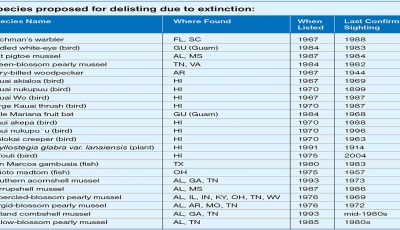Navy asserts compliance with ESA
The Department of the Navy asserted yesterday their compliance with the Endangered Species Act (ESA) over a Marianas training project under fire from local and national groups over an alleged failure to comply with environmental law.
In February, counsel for Earthjustice and Center for Biological Diversity (CBD), representing multiple parties, sent a letter to the Navy and the
U.S. Fish and Wildlife Service giving notice of their intent to sue the two
agencies for alleged violations of the ESA during implementation of the Mariana Islands Training and Testing program or MITT.
The Navy said yesterday that they responded by providing Earthjustice and CBD with information they did not have: “specifically, that Navy had reinitiated consultation with the U.S. Fish and Wildlife Service, in accordance with the 2015 Biological Opinion, to ensure that Navy’s training activities remain fully compliant with all relevant provision of the ESA.”
“The Navy believes it has addressed the concerns raised by Earthjustice and CBD in their notice letter,” Joint Region Marianas said in a statement to Saipan Tribune.
PaganWatch co-founder Peter Perez on Tuesday that the groups were “in talks with the Navy to determine whether the Navy is taking the necessary steps to comply” with the ESA, and Earthjustice also said the Navy had provided the promised information, which they were reviewing.
“We would be pleased if our notice letter prodded the Navy into complying with its
obligations under the ESA, but are not yet in a position to say whether or not it has. If the Navy does not take the necessary steps to comply with its duty to protect the newly listed species, we intend to take the Navy to court,” Perez told Saipan Tribune on Tuesday.
In the February letter, Earthjustice attorney David Henkin said the Navy and the Service had violated and remains in ongoing violation of the ESA, arguing that the newly listed species should have reinitiated consultation between the Service and Navy.
The Service ruled that the MITT project opened up “every island” within the Marianas as a “potential training site,” which could lead to “negative impacts to any number” of the newly listed 23 species under the ESA.
The project’s training increases in Guam, Rota, Saipan, Tinian, Pagan, and increased bombing of Farallon de Medinilla promised “likely negative impacts” of direct damage to species from live-fire or ordnance training, wildfire, trampling, and spread of nonnative species, the Service said.
Quoting this ruling, Henkin said in February that the new rule made clear that the Navy training might affect the newly listed species—“triggering the obligation to reinitiate consultation.”
Last August, the Navy gave the go-ahead on the MITT project, to replace a smaller scale one approved five years ago.
Among undersea sonar training, the Navy approved strike, amphibious, anti-surface, electronic, anti-submarine, and mine warfare, among others.
It approved use of F-35 joint strike fighter aircraft, aircraft carrier, destroyer class vessel, and amphibious combat vehicles and unmanned vehicle and aerial systems.
This is inclusive of numerous rocket and projectile munitions and “kinetic energy weapons” or rail guns that use energy to accelerate projectiles to supersonic levels, according to decision-making documents.
The Navy also approved state-of-the-art high-frequency sonar systems to be operated from Navy vessels.

























